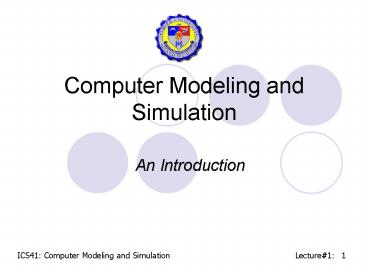Computer Modeling and Simulation - PowerPoint PPT Presentation
1 / 20
Title:
Computer Modeling and Simulation
Description:
... time between two incoming flights or number of defective parts ... assume that the arrival of cars as well as their service times are random. 15 ... – PowerPoint PPT presentation
Number of Views:2354
Avg rating:5.0/5.0
Title: Computer Modeling and Simulation
1
Computer Modeling and Simulation
- An Introduction
2
Simulation
- is a tool to evaluate the performance of a
system, existing or proposed, under different
configurations of interest and over long period
of real time.
3
Simulation
- is to pretend that one deals with a real thing
while really working with an imitation - in operations research, the imitation is a
computer model of the simulated reality - example
- flight simulator in a PC
4
Model
- is a representation of the construction and
working of some system - similar to but simpler than the system it
represents. - for a simulation study, a model is a
mathematical model developed with the help of a
simulation software.
5
Why use a model?
- cheaper
- safer
- saves time than real system
6
When to use simulation?
- systems that changes with time
- systems that involves randomness
7
Modeling
- is the process of producing a model
8
Model Classifications
- deterministic (input and output variables are
fixed) - stochastic (at least one of the input or output
variables is probabilistic) - static (time is not taken into account)
- dynamic (time-varying interactions among
variables are taken into account).
9
System Terminology
- State
- A variable characterizing an attribute in the
system such as level of stock in inventory or
number of jobs waiting for processing - Event
- An occurrence at a point in time which may
change the state of the system, such as arrival
of a customer or start of work on a job.
10
System Terminology
- Entity
- An object that passes through the system, such
as cars in an intersection or orders in a
factory. Often an event (e.g., arrival) is
associated with an entity (e.g., customer). - Queue
- A queue is not only a physical queue of people,
it can also be a task list, a buffer of finished
goods waiting for transportation or any place
where entities are waiting for something to
happen for any reason.
11
System Terminology
- Creating
- Creating is causing an arrival of a new entity
to the system at some point in time. - Scheduling
- Scheduling is the act of assigning a new future
event to an existing entity.
12
System Terminology
- Random Variable
- is a quantity that is uncertain, such as
interarrival time between two incoming flights or
number of defective parts in a shipment. - Random Variate
- is an artificially generated random variable.
13
System Terminology
- Distribution
- is the mathematical law which governs the
probabilistic features of a random variable.
14
Example
- Building a simulation gas station with a single
pump served by a single service man - assume that the arrival of cars as well as their
service times are random
15
Solution (1)
- At first identify the
- states
- events
- entities
- queue
- random realizations
- distributions
16
Solution (1)
- after identification of the different system
requirements, you will come up with the different
values - states
- Number of cars waiting for service, number of
cars served at any moment - events
- Number of cars, start of service, end of service
- entities
- cars
17
Solution (1)
- queue
- The queue of cars in front of the pump, waiting
for services - random realizations
- inter-arrival times, service times
- distributions
- assume exponential distribution for both
inter-arrival time and service time
18
Solution (2)
Arrival Routine
19
Solution (2)
Departure Routine
20
Advantages of Simulation
- to reduce the chances of failure to meet
specifications - to eliminate bottlenecks
- to prevent under or over-utilization of
resources and - to optimize system performance.































